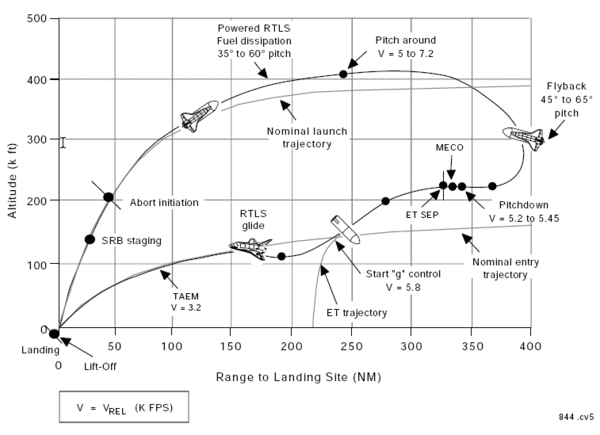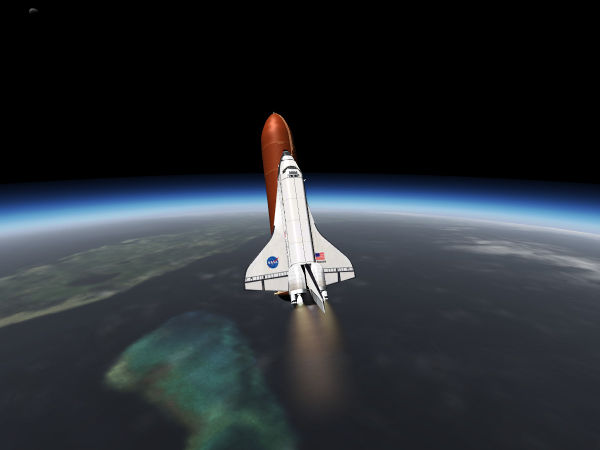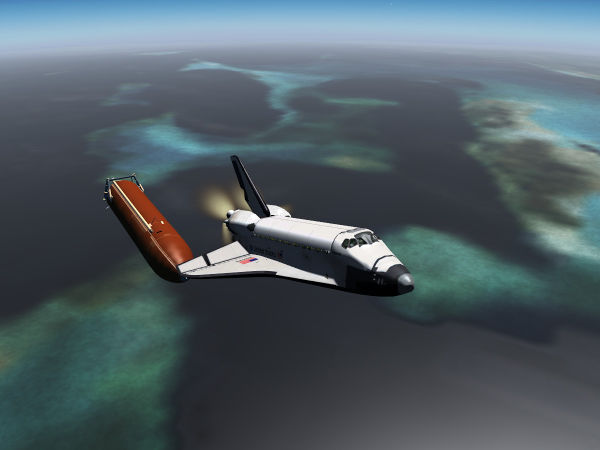Flying the Shuttle - Abort Procedures Overview
| Space flight |
|---|
| in FlightGear |
| Space Shuttle |
| Vostok-1 |
| Note This article refers to the SpaceShuttle in the FGAddon repository. |
What are we trying to do?
As discussed in the article describing launch, the propellant load of the launch stack is such that a Shuttle with payload can be lifted into a higher inclination orbit, to an altitude of perhaps 600 km max, but there is usually no large margin for error. Also, during launch, not all energy is expended in actually bringing the Shuttle to orbital speed, a part is needed to keep it high enough outside the atmosphere during the acceleration phase.
It follows that if an engine is lost during ascent, the efficiency of the launch process drops. The Shuttle ends up with less acceleration, making the time to reach orbital speed longer, implying that more energy is needed to simply keep it at altitude while it increases velcoity. In fact, even with three engines, just after SRB separation the Shuttle has less than 1 g of acceleration and, till enough propellant is depleted, could not even hold itself against Earth's gravity. If one engine is lost at this phase, there is barely 0.6 g left and the Shuttle will inevitably fall for almost a minute.
In general, the loss of an engine will cause a certain underspeed as compared to the three-engine case when the propellant is depleted. Close to MECO this might not be serious at all - engines are throttled back to limit acceleration anyway, so if one engine is lost, the rest can be throttled up. Just after liftoff on the other hand, an underspeed will have severe consequences and the Shuttle might never be able to reach orbit.
Abort procedures are designed to manage the loss of a single or more engines during ascent. There are two different classes of procedures - performance aborts and contingency aborts. Performance aborts aim to bring the orbiter safely down onto a runway, i.e. they contain a focus on trajectory management and ranging. Contingency aborts aim to bring the orbiter in such a state that the crew can bail out before a crash landing and in general just focus on making the entry back into the atmosphere survivable.
Launchpad abort
The simplest case of an abort procedure is on the launchpad. After the three main engines receive the ignition command, there is an about three second delay till the ignition command to the SRBs is given. If any of the main engines did not reach at least 90% of rated power during that time, the ignition command to the SRBs is not given and all the main engines are commanded off. Since the thrust of the SSMEs is not sufficient to actually lift the stack of the pad without the SRBs, the Shuttle rocks a bit as a result, but never leaves the pad. After a launchpad abort, the crew leaves the vehicle and the launch is postponed.
In FG, the launchpad abort will typically happen for one of the following reasons:
- the condition of an engine is set to damaged, preventing it from reaching sufficient thrust
- an APU/hydraulics system was not started properly (or is damaged), causing the engine to be unable to throttle
- the throttle lever was not moved to 'full open' position during the ignition procedure
Just as in real life, you have to get out of FG and re-try another time.
Return to Launch Site
The Return to Launch Site (RTLS abort) procedure is designed for loss of an engine just after liftoff up to perhaps 3:30 into the flight. It aims to bring the Shuttle back to a landing at the launch site and for that reason is very different from the way the Shuttle normally operates. It also is the most difficult abort procedure, as there are several elements which are time-critical and can go wrong easily. The basic pattern is summarized in the following diagram:
The abort is declared after SRB separation outside the atmosphere. From there, there are three distinct phases - powered flight, coast and ET separation and final glide.
The powered flight phase starts extremely low on thrust. At that stage, the main aim is to deplete propellant. Pitched highly upwards (up to 60 deg) to vector thrust downward and minimize loss of altitude, the Shuttle continues to accelerate downrange. At a turning point, the Shuttle then pitches around rapidly (about 10 deg/s) and starts to decelerate, still vectoring thrust downward. All the time the trajectory drops, and pitch should be adjusted such that by the time of MECO, it has come down to about 220.000 ft but not significantly lower
After pitch around, the Shuttle eventually reaches a turning point and starts to accelerate back to the range. As propellant depletes and ET weight is reduced, acceleration reaches up to 3 g and the Shuttle becomes very maneuverable again, allowing it to reach up to Mach 7 pointed back towards the landing site.
Timimg for the pitch-around is critical - wait too long and the Shuttle will not make it back to the site, turn too early and the Shuttle will overshoot. The proper indicator for the pitch-around is the amount of propellant remaining, dependent on the time when the engine failed. Refer to the following cue card:
| failure time | pitch around |
|---|---|
| 0:00 | 44% |
| 0:30 | 47% |
| 1:00 | 47% |
| 1:30 | 48% |
| 2:00 | 51% |
| 2:30 | 51% |
| 3:00 | 52% |
| 3:30 | 53% |
The next step is to fly the Shuttle at MECO to a safe attitude to separate the external tank. Since the tank is a huge device, it feels quite some atmospheric drag and should ideally be separated as high up in the atmosphere as possible. However, since the Shuttle is very far from orbital velocity, it should ideally make the transition from powered to gliding flight as low in the atmosphere as possible to avoid dropping very rapidly.
The result is a compromise - the idea is to separate the ET between a qbar of 1-2 psf, at an alpha of about -2 deg (for this the Shuttle needs to be pitch down in the last moments of the flight) with no more than 2% propellant remaining to avoid sloshing and in addition all rotation rates nulled (use the RCS attitude hold mode quickly).
Since the Shuttle is just feeling the fringes of the atmosphere, it will start to drop rapidly (i.e. almost accelerating 9.8 m/s downward every second) and plunge into the dense atmosphere. As soon as the atmosphere catches, forces will ramp up quickly. The aim of the next few seconds is to survive this.
Pitch needs to be brought up rapidly to 50 deg and the Aerojet DAP needs to be on. The Shuttle may reach vertical speeds in excess of 500 m/s before the atmosphere shows significant effect. Then watch acceleration ramp up - as soon as the acceleration reaches 2.2 g, pitch has to be reduced to lessen the forces. Pitch needs to be managed such as to keep the acceleration on the vehicle close to that number till the acceleration lessens and the vertical speed reduces to less than 100 m/s.
If the Shuttle survived the contact with the atmosphere, the remaining task is to manage azimuth and range to the site. For this, one returns to the normal techniques of flying Mach-dependent AoA and using bank angle to manage sink and drag or S-turns for ranging, all intended to bring the Shuttle to a regular TAEM interface.


